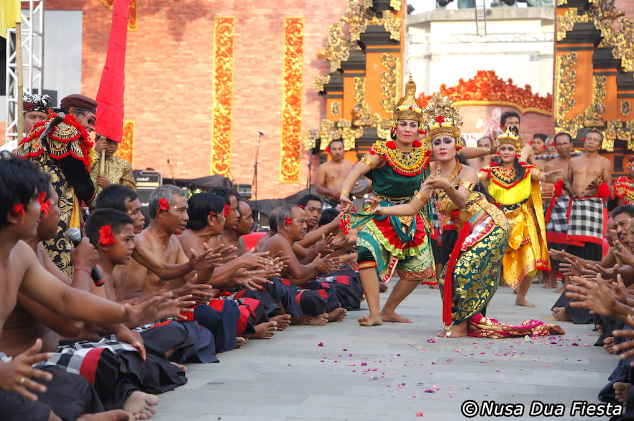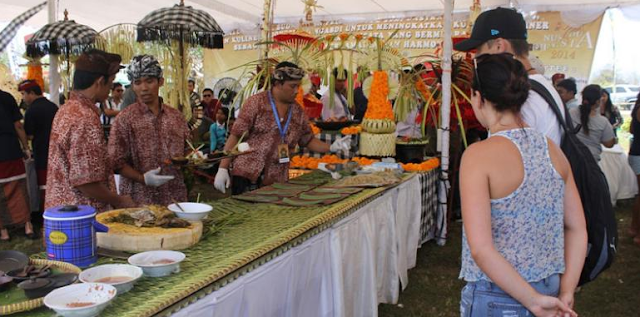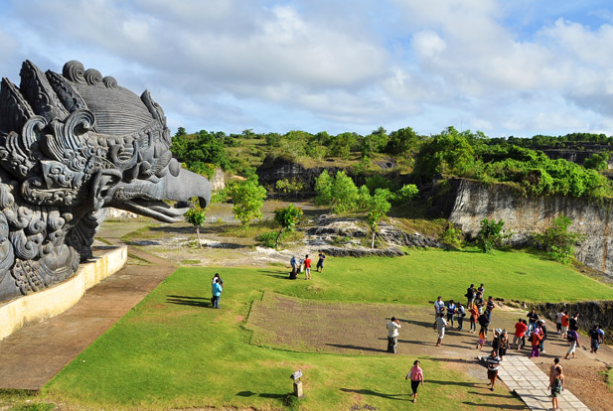The most
Strange Beautiful places to visit on the island of Bali
Discover
Bali’s strangely beautiful places on Earth.
Bali is a mystical place to visit.
I will share some unique places that you, and you will unlikely to see
anywhere else in this world. Some places to pronounce bizarre, others eerie
and mysterious- spread out across Bali, from the Bali big island to the small islands of Lembongan and Nusa
Penida. These places are not well-known
to tourists, But they are familiar to some locals. If you would like to experience something
unusual and out of your comfort zone, you should come and visit these strange
beautiful places.
1. Desa Bali Aga Trunyan Necropolis
Kintamani
The mountain village of Trunyan can be found at the foot of Mt.
Abang, at a remote and isolated location on the eastern shore of Lake Batur.
The Trunyanese are often referred to as Bali Aga (mountain Balinese), which
refers to a conservative, pre-Hindu way of life with ancient, neolithic customs
and a very definite avoidance of outside influences. Instead of the term “Bali
Aga, the term Bali Mula (‘original Balinese’) is often used instead. In this
respect it should be noted that the Bali Aga are in no sense ‘original’.
Therefore the term ‘Mountain Balinese’ is, from a historical perspective, more
correct. The Bali Aga namely have always occupied their ancestral villages from
choice and performed their traditional crafts and trades appropriate to the
nature of the land. According to copper plate inscriptions found in one of the
shrines in the main temple of Trunyan, the temple must be dated back to at
least the 10th century AD (833 Çaka). The village itself, however, is believed
to be much older than the temple.

Contrary to elsewhere in Hindu Bali the Trunyanese do not cremate their
dead. Instead, after a ritual cleansing with rainwater, the body of the
deceased is placed in a bamboo cage under the taru menyan tree ( special
fragrant tree) is known to only grow here. Until the forces of nature, in
particular the wind, has dissolved the body tissues until only the skeleton
remains. Then the skull is placed on a stairs-shaped stone altar which is
located some 500 meters north of the Banjar Kuban, a special place which can
only be reached by boat. It is mesmerizing to many is no odor from the
decomposing bodies are present, which the locals believe is neutralized by the
tree’s myrrh-like fragrance. Skulls and bones on moss-covered stairs are
quite the scene here, definitely not for the nervous type.
Location: Trunyan Village Kintamani
2. The 'Bat Cave' Temple of Goa Lawah
Klungkung
The Goa Lawah temple is one of the six most important temples in Bali. The Goa (cave) and Lawah (bats). So you
can say that this is a temple with the form of a cave where you can see
thousand of bats inside the cave. It is
said that this temple was built to honor the sea gods and beside the bats, it
is also said that 2 giant snakes live in the cave that considered as the
guardian of the cave. The snakes are a couple, where one of the giant snake is
a male and another one is a smaller female.
I was lucky to meet one of
the snakes when I spent my night meditation with the priest, during full moon
ceremony.
Location: In the Pesinggahan Village, Dawan district, Klungkung Regency,
Bali, which is about 10 km to the east of Klungkung city or around 50 km from
Denpasar city.
3. The 'Ghost Town' of Taman Festival Bali
Sanur
I remember when I was high school this place was I hung out with my
friends. A beautiful water park. Located at North in Sanur, now a spooky
‘ghost town’ on Padanggalak Beach, a remote coast far away from the main Sanur
tourist area. It is the vast ruins of the derelict theme park Taman Festival,
Bali, which closed down shortly after its establishment in 1997. Because
of no plans are underway for its resurrection, so we believe it will still be
around for a while. The deserted main entrance gates, ticket booths, empty
cafeterias and deteriorated main buildings with partly collapsed roofs all give
it a creepy sensation even in broad daylight. Dense foliage and creeper vines
have grown over broken windows, and ornamental stone figures loom over in the
open spaces, making it a great spooky site. The locals believe long-abandoned
sites like this are ‘borrowed’ by lost spirits. Recently, I visited this site
on the way to Ubud, and the ambience give me goosebumps. If you like horror movies, you will enjoy
this place.


Location: Jalan Padanggalak, Padanggalak Beach, Sanur
In the remote Balinese village of Bengkala Singaraja every one of the
3,000-odd residents can fluently communicate in kata kolok, a century-old sign
language, and people with speech and hearing deficiencies are always treated with
respect.
That so many people would bother to learn sign language might seem
strange, but there’s a good reason behind the unique tradition – the number of
hearing and speech impaired in Bengkala is about 15 times higher than the world
average and it’s believed to have been even higher in the past. So it’s only
natural that, in time, body language took precedence over the words, and
villagers developed their own unique sign language which has been passed on for
centuries. The high incidence of
deafness is apparently caused by the geographically-centric recessive gene
DFNB3, present in the village for over seven generations.
5. The Underground House (Goa Gala-Gala)
Nusa Lembongan
The Underground House or Goa Gala-Gala in Nusa Lembongan was built by
Mangku Vyasa. He is a farmer, dancer and
Mangku Dalang (puppet shadow performer). Due to his profession as a Dalang, he
was inspired by one of Mahabharata episodes, “Wana Parwa”; the twelve years in
exile in the forest. In the story Pandawas decided to build a cave, Gala-gala,
to protect his family from Korawas who wanted to find and kill all of
Pandawas’s family.
The top of Goa Gala-Gala looks like the house in general, in the yard is
overgrown trees. However, in some corner of a hole as deep as 3 meters, as
access to the entrance to the Gala-Gala. Once down the stairs, which looks
first are the pillars of the land and the hall in different directions. The
House Gala-gala is complete because he had a sleeping room, dining room, living
room, to the kitchen. The Cave’s ceiling
is just as high as 1.5 meters make oxygen is thinner than on the surface.
Location: Desa Lembongan, Kecamatan Nusa Penida, Kabupaten Klungkung,
Bali.
6. The Goa Gong temple Jimbaran (The
Stalactite Cave Temple )
The Goa Gong temple is a unique cave temple hidden away not so far from
Kuta beach, the Jimbaran resort area. Up the hill from the Kedonganan,
the namesake Jalan Goa Gong leads you through the small Batu Ngongkong
community and a sharp left turn puts you face to face with a pair of big cat
statues. The Erie statues under a banyan
and tamarind tree guard a flight of stairs to the cave opening. The temple’s
keeper and priest Mangku Gurun Simpen is
normally you see on the site. Inside, a large, dim-lit cavity reveals
dedicated stone shrines with soothing sounds of dripping water from the rocky
cave stalactites. A huge stalactite
hangs behind the shrines, which is in fact a functioning stone gong. It is
struck during rituals, particularly during the temple festival ceremony.
The existence of the site is quite old and described as "Pura Bukit
Gong" in the ancient manuscript of Dwijendra Tatwa.
The community said, when Dang Hyang Nirartha (the holy
priest from East Java) arrived in the area of Uluwatu, he first meditated and
invoked the guidance to build the shrine Uluwatu near Jimbaran.
It is one of the important temples in Bali.
7. The Goa Peteng (The 'Dark Cave) of
Jimbaran
This cave is not far away from the Goa Gong. It is the opposite entrance to Pura Goa Gong,
with the entrance (on the right and left side) guard by two dragon
statues.
Actually, the soft and delicate sound of the Gong comes from the big rock that blown by the wind gusts
and the reflection in the cave. This place is full of mystique vibes, spiritual
energy, healing energy, and this place recommended to those who
seeking spiritual development or healing for body,
mind and spirit.
At this location appeared holy
water source (where the priest starts the meditation). Furthermore, this water
source is used as Tirta. The holy water is also believed to have the positive
and powerful energy to cure diseases.
8. The Goa Giri Putri Nusa Penida
This cave is one of my favorite places for my group meditation.
The Giri Putri cave is located near the Karangsari village. Before arriving at the mouth of the cave, we
need to climb up about 100 stairs. The
entrance of the cave is so narrow that must kneel to enter. Inside, we are
surprised by its volume. It is very dark inside, but a big opening space and
temple in the cave. It’s beautiful
inside and close to the exit, you will discover a Hindu temple, a Buddhist
temple, and Confucian followers, evidenced by the presence of a statue of Dewi
Kwan Im here.



















































